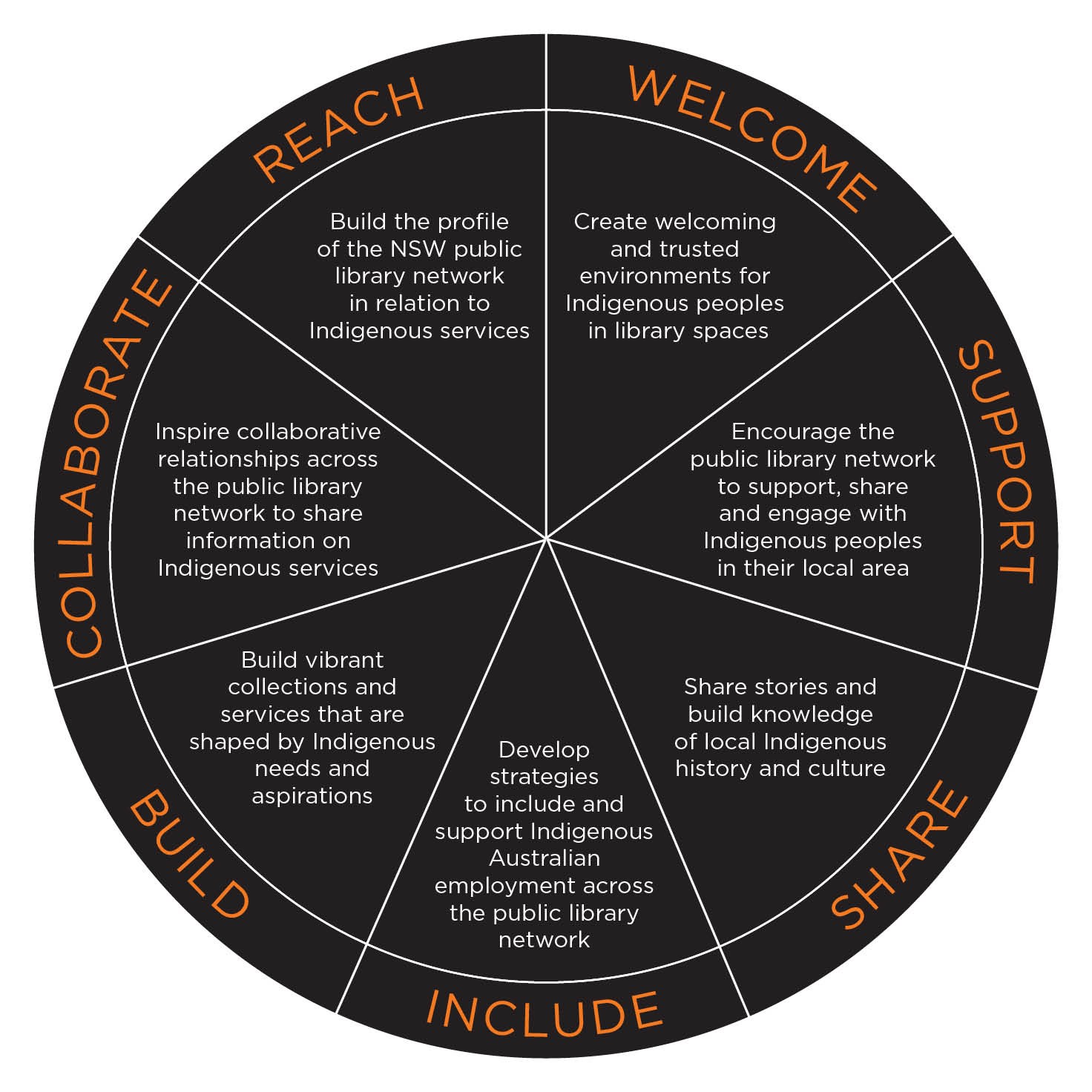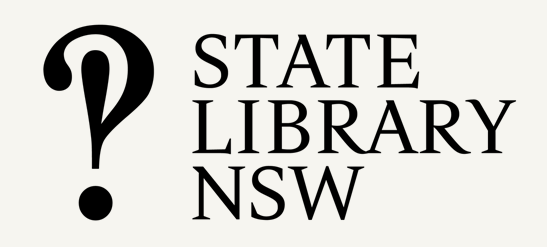Background
The State Library of NSW Indigenous Engagement branch was established in 2013 as a driver for action in relation to Aboriginal and Torres Strait Islander services and collections. This included working collaboratively with the Public Library Services branch.
The two branches saw significant opportunities to develop services and support to assist NSW public libraries to increase engagement with local Aboriginal and Torres Strait Islander communities and to support the implementation of the ATSILIRN Protocols across the public library network. To understand the extent of support needed and establish a baseline for developing future services, a survey was circulated to public library managers to gauge:
- the extent of current collections and services targeting Aboriginal communities
- the number of public libraries employing Aboriginal and/or Torres Strait Islander staff, and the positions in which they were employed.
Thirty-two questions were developed from nine subject areas related to various ATSILIRN Protocols: staffing, cultural competency, events targeted to the local Aboriginal community, acknowledgement of Aboriginal and Torres Strait Islander cultures in the library space, collaboration with external Aboriginal and Torres Strait Islander stakeholders, Aboriginal and Torres Strait Islander collections, awareness and use of the ATSILIRN Protocols, challenges in engaging with Aboriginal and Torres Strait Islander clients, assistance the State Library of NSW could provide. The online survey specifically considered activities and projects of public libraries across NSW targeted for local Aboriginal and Torres Strait Islander populations in the period 2013-2015.
There was an extremely poor response rate to the survey, which was the first indicator of the need for continued discussion in the above areas, and the relatively low priority given to them. From the responses that were received, we saw a general enthusiasm and willingness for promoting and developing library services, programs and collections dedicated to Aboriginal and Torres Strait Islander people and communities. While a very small percentage of libraries offered programs and/or activities related to Aboriginal languages, family history and other targeted areas, there was a readiness for some to consider them in the future and to work with the State Library to develop them.
In relation to employment, the survey results showed a lack of Aboriginal and/or Torres Strait Islander identified positions, and of Aboriginal and/or Torres Strait Islander employees. From 2005 (when the last survey of this kind was conducted) to 2015, the number of Aboriginal and/or Torres Strait Islander people employed in the sector had actually decreased at an alarming rate. Of the libraries that employed Aboriginal and/or Torres Strait Islander staff, almost half reported that there was an increase in Aboriginal people accessing their library.
The survey showed that more concentrated work was needed to implement the ATSILIRN Protocols through the network, including, for example, in areas such as ‘Accessibility and use’, collections development and in creating welcoming spaces.
From the survey results the need for a concerted effort to encourage and support public libraries to embed Aboriginal priorities in NSW public library services, programs and collections was clear. In 2016, the Library Council of NSW’s Public Libraries Consultative Committee (PLCC) endorsed Indigenous Spaces in Library Places, a five-year strategy for the State Library of NSW to assist the state’s public library network.
Description
Indigenous Spaces in Library Places: Building a Vibrant Public Library Network Inclusive of Indigenous Peoples and Communities was developed to provide guidance to public libraries, as part of the State Library’s ongoing commitment to enhancing services dedicated to the Aboriginal and Torres Strait Islander population of NSW.
The strategy aims to create interest in and awareness of the way public libraries can provide a culturally safe and welcoming space for Aboriginal peoples and communities, building inclusive collections and services. In the strategy, ‘Library Places’ refers to a conceptual arena where libraries engage not only with Aboriginal peoples accessing the library building, but also with their histories, issues and perceptions across the community.
It is important to note that this strategy is in its first iteration and will change over time, as priorities for both public libraries and communities continue to evolve. This iteration is specifically targeted towards public library staff who need help getting started in this area, but best practice would ensure that in future programs, services and collections will be co-designed with Aboriginal and Torres Strait Islander communities according to their specific priorities and concerns. The strategy is not intended to be rigid and/or prescriptive.
Building an influential community of practice that can inspire the library sector, while building capabilities among communities is an important objective of the strategy. To achieve this, the Library works closely with public libraries, building cultural competence, providing ongoing support and training, and publishing free online resources, such as the Indigenous Spaces in Library Places online toolkit.
The seven key objectives of the strategy are to:
- Welcome: Create welcoming and trusted environments for Aboriginal and Torres Strait Islander peoples in library spaces.
- Support: Encourage the public library network to support, share and engage with Aboriginal and Torres Strait Islander peoples in their local area.
- Share: Share stories and build knowledge of local Aboriginal and Torres Strait Islander history and culture.
- Include: Develop strategies to include and support Aboriginal and Torres Strait Islander employment across the public library network.
- Build: Build vibrant collections and services that are shaped by Aboriginal and Torres Strait Islander needs and aspirations.
- Collaborate: Inspire collaborative relationships among the public library network to share information on Aboriginal and Torres Strait Islander services.
- Reach: Build the profile of the NSW public library network in relation to Aboriginal and Torres Strait Islander services.
The strategy’s objectives are designed as a pie chart in which all seven components are equal, acknowledging that each library is at a different stage of relationship-building with their local Aboriginal community, and may be more comfortable in some areas than others, but ultimately all areas of the strategy should be considered equal in importance and work together to inform a holistic approach to building ‘Indigenous Spaces in Library Places’.

Outcomes
Toolkit and case studies
A major outcome was the development of the Indigenous Spaces in Library Places online toolkit, from which public library staff can download customisable resources, such as an Acknowledgement of Country poster, Special Care notices for sensitive/restricted collection materials, and Aboriginal-flag spine labels. Toolkit users can also contact the Indigenous Engagement team, contribute feedback on the toolkit, and share their own case study success stories. Case study submissions have been received from New South Wales, Queensland and Canadian public libraries as examples of best practice both nationally and internationally. Three examples relating to strategy objectives are:
- Katoomba Library’s Aboriginal Knowledge Collection creating a welcoming space
- Kempsey Library’s diverse partnerships allowing them to support community-driven initiatives
- Oakey Library’s establishment of the Gooneburra Gardens and mural encouraging collaboration, learning and a greater understanding of native foods and local Aboriginal and Torres Strait Islander history and culture.
Training programs
To support public library staff in working towards the objectives of the strategy, the Indigenous Engagement team has also developed training programs in targeted areas such as family history and cultural competency.
The Tracing Ancestors program, a workshop to equip communities and public library staff with the skills and confidence to begin researching Aboriginal and Torres Strait Islander family history, was launched in 2016. Aboriginal family history information requests are among the primary reasons people contact the Indigenous Engagement team, or their local public library. Since the program launched there has been a marked increase in requests for the program from across the public library network, showing a clear need for training on the subject, and that the program can also be a great way to facilitate relationship-building between public library staff and communities. In 2017 and 2018, the Indigenous Engagement branch ran the workshop at nine public libraries, including four regional locations, and seven community centres and/or conferences.
Indigenous Engagement and Public Library Services also offer 40 licenses each year to NSW public library staff to undertake cultural competence training run by the Centre for Cultural Competence Australia (CCCA). The course, designed as a precursor to face-to-face training, is offered online allowing staff across the state to complete the training as a cohort and to share learnings and feedback with the Indigenous Engagement team. After completing the course, the cohort comes together for an informal ‘unconference’ to debrief, share ideas and develop action plans for implementation in their libraries. Some great feedback from the 2017 program came from two Unconference participants:
“Spending time talking about how to make our library services more inclusive for Indigenous communities is important and valuable, and something we don’t spend enough time on. Finishing the Cultural Competency Course was an invaluable experience and afforded me the opportunity to really reflect on what my library service was doing and how we could do things better.”
“By the end of the day I was able to clearly visualise what my library service could do to make ourselves more inclusive and welcoming. Something as simple as recognising the land in which my library is situated on the front door or putting the flag in a visible location is a great start. I realised that I don’t need to be in a hurry to do everything, that there are some basic, simple things to start with to reach the long-term goal of inclusivity and inclusion.”
Feedback for the toolkit and both programs has been overwhelmingly positive so far. Once the five-year strategy comes to term in 2021, the library plans to run another survey to measure the reach and influence of the strategy, and the implementation of the ATSILIRN Protocols across the network.
Lessons learnt
- Community of practice: There is a great need for a community of practice in which public libraries can reference and build on guiding principles, and support and learn from each other.
- Leadership: Change begins with strong leadership not only at a state level, but at a local level.
- The ‘first step’ is the hardest: Public libraries are often keen to engage with their local Aboriginal and Torres Strait Islander communities but don’t know where, or how, to start, and may need support in taking this first step.
- No ‘one size fits all’ solution: Every library is at a different stage in terms of the relationship they have built with their local community; there is no ‘one size fits all’ and a tailored approach is necessary. Solutions may work for some but not others.
- Cultural competency is key: Bolstering cultural competency across the public library network is key to enhancing staff confidence, services, programs and collections dedicated to local Aboriginal and Torres Strait Islander communities, and creating welcoming library spaces.
- Sharing learnings:Better outcomes are achieved through online cultural competency training when staff are able to get together to discuss and embed learnings, receive regular updates from the Indigenous Engagement team, and access a dedicated online space with supporting resources.









